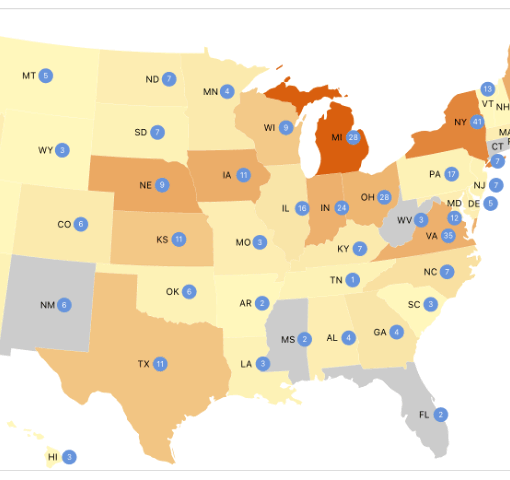Last Thursday, May 18, a state appellate court affirmed the trial court’s dismissal of Town of Copake v. New York State Office of Renewable Energy Siting, a lawsuit challenging the state’s March 2021 regulations for siting and permitting major renewable energy facilities. While the appellate court’s decision to uphold the regulations may not attract much attention in the press, a decision invalidating the regulations could have had serious repercussions for the state’s siting process and jeopardized the state’s ability to meet its goals for reducing emissions and scaling up renewable energy production under the Climate Leadership and Community Protection Act of 2019 (CLCPA). It is not known yet whether the petitioners will appeal to the state’s highest court.

Statutory Background
In April 2020, the New York Legislature enacted the Accelerated Renewable Energy Growth and Community Benefit Act, which created the Office of Renewable Energy Siting (ORES) and established a new siting process for major renewable energy facilities. The new siting process, now codified at Executive Law § 94-c, has several key features that ensure reasonably prompt decisionmaking and limit the ability of local governments to block renewable energy projects. These include the following:
- ORES has exclusive jurisdiction over on-shore renewable energy projects of at least 25 megawatts (MW). Developers of projects between 20 MW and 25 MW may opt-in to review by ORES instead of local review.
- ORES is authorized to “elect not to apply, in whole or in part, any local law or ordinance which would otherwise be applicable if it makes a finding that, as applied to the proposed major renewable energy facility, it is unreasonably burdensome in view of the CLCPA targets and the environmental benefits of the proposed major renewable energy facility.” In other words, ORES can preempt local restrictions on a case-by-case basis if applying the restriction would impede the state from meeting its CLCPA targets, including that (a) 70% of the state’s electricity be generated by renewable energy sources by 2030 and 100% from zero-carbon sources by 2040 and (b) statewide emissions must be reduced 40% from 1990 levels by 2030 and 85% by 2050.
- ORES must determine within 60 days of receiving an application to site a renewable energy facility whether the application is complete. In addition, within one year of determining that an application is complete, ORES must make a final decision on permitting (unless the project is on brownfields or other degraded land, in which case ORES must decide within six months).
For more information about the new siting process, see my previous blogs here and here.
Lawsuit Challenging ORES’s Regulations
In March 2021, ORES promulgated regulations to implement the new siting process, as required by statute. Shortly afterward, in June 2021, a coalition of upstate towns and other interest groups (collectively, the “petitioners”) filed a lawsuit to invalidate the regulations. In their lawsuit, the petitioners alleged, among other things, that ORES violated the State Environmental Quality Review Act (SEQRA) by promulgating the regulations without preparing an environmental impact statement (EIS) and otherwise failing to take a “hard look” at the impacts of the regulations. The petitioners further alleged that ORES’s regulations were ultra vires because they would allegedly achieve adverse environmental outcomes, which would violate the enabling statute’s requirement to establish uniform standards and conditions that “avoid or minimize, to the maximum extent possible, any potential significant adverse environmental impacts.” Finally, the petitioners alleged that ORES’s regulations violated the home rule provisions of Article IX of the New York State Constitution by unreasonably allowing waiver of local laws on matters of local concern.
The Albany County Supreme Court rejected the lawsuit on all counts in a pair of decisions issued in September 2021 and October 2021. The petitioners then appealed to the Appellate Division, Third Department (“Third Department”).
Arguments on Appeal
In their appeal, the petitioners made three arguments.
First, the petitioners argued that the Albany County Supreme Court erred in holding that ORES had conducted the environmental review required by the SEQRA when promulgating the regulations. More specifically, they argued that ORES violated SEQRA in three distinct ways, namely: (a) by misclassifying the issuance of regulations as an Unlisted action rather than a Type I action within the meaning of the SEQRA regulations; (b) by failing to take a “hard look” at the environmental impact of its regulations; and (c) by improperly deferring environmental review until applications for individual projects are submitted and thus unlawfully segmenting review. Under the SEQRA regulations, a Type I action “carries with it the presumption that it is likely to have a significant adverse impact on the environment and may require an EIS.” The SEQRA regulations offer examples of activities that should be considered as Type I actions, one of which is “a nonagricultural use occurring wholly or partially within an agricultural district” on more than 2.5 acres. Petitioners argued that, because renewable energy projects are nonagricultural uses and the regulations facilitate siting such projects on agricultural land, the issuance of the regulations was a Type I action.
Second, the petitioners argued that the Albany County Supreme Court erred in holding that the ORES regulations were consistent with the requirements of the enabling legislation, Executive Law § 94-c. Specifically, they argued that ORES’s failure to adequately conduct adequate environmental review made it impossible for ORES to comply with Executive Law § 94-c, which required ORES to establish uniform standards and conditions that “avoid or minimize, to the maximum extent possible, any potential significant adverse environmental impacts.”
Third, the petitioners argued that the Supreme Court erred in holding that the ORES regulations governing waiver of local laws do not violate the Home Rule provision of Article IX of the New York State Constitution. The petitioners noted that Article IX provides that “every local government shall have power to adopt and amend local laws not inconsistent with the provisions of this constitution or any general law relating to its property, affairs, or government.” The petitioners further noted that Article IX provides that consistency with state law “shall be liberally construed.” The petitioners argued that ORES “seeks illegally to preempt the Home Rule powers of local governments” by promulgating regulations that allow ORES to set aside local restrictions that are otherwise consistent with the general laws and state constitution
For more information about the appeal, and the amicus brief we submitted on December 2, 2022, please see my previous blog post here.
Third Department’s May 18, 2023 Decision
In its decision last week, the Third Department agreed with the petitioners’ threshold argument that ORES “misclassified” its promulgation of the siting regulations as an “Unlisted” action (instead of a “Type I” action) within the meaning of the SEQRA regulations. As discussed above, one of the enumerated examples of a Type I action in the SEQRA regulations is “a nonagricultural use occurring wholly or partially within an agricultural district” on more than 2.5 acres. Here, the court held that “given that the regulations authorize the siting of massive renewable energy facilities, the regulations will alter agricultural property, which . . . necessitates classification as a type I action.”
However, despite agreeing with the petitioners that ORES misclassified the regulation, the Third Department explained that misclassification is not fatal if the agency “conducts the equivalent of a type I review notwithstanding the misclassification.” Here, the court found that ORES “took a thorough and hard look at the potential negative environmental impacts associated with the proposed regulations,” thus satisfying its obligations under SEQRA. The court noted that this review included conducting seven public hearings, responding “extensively” to public comments, and considering previous reviews undertaken by other agencies.
The court also rejected the petitioners’ argument that ORES improperly deferred environmental impact review by not considering the consequences of approving projects that will be submitted under its regulations. The court held that “[e]nacting these regulations is not part of a segmented or deferred review, but rather a pragmatically-based SEQRA review that is designed to review the regulations themselves, rather than review the future impacts of particular projects that are otherwise exempt from SEQRA.”
In addition to rejecting the petitioners’ SEQRA-based claims, the court rejected the petitioners’ argument that ORES exceeded its statutory authority under Executive Law § 94-c. The court noted that the statute directed ORES to issue regulations to implement the siting process and that ORES “simply fleshed out the details of the siting regimen” as directed.
Likewise, the court found that ORES did not violate the Home Rule provision set out in Article IX of the New York State Constitution. The court explained that, under Third Department precedent, “where State interests are involved to a substantial degree, in depth or extent, the State may freely legislate without home rule approval, notwithstanding the legislation’s impact on local concerns.” The court further explained that, under Third Department precedent, “comprehensive regulatory schemes” for siting public utilities, such as the siting process at issue in the lawsuit, preempt local zoning ordinances.
Conclusion
The May 18 decision upholding the ORES regulations is a positive development for the renewable energy industry in New York, and it will help the state to achieve its goals for scaling up renewable energy generation and reducing emissions under the CLCPA. With respect to SEQRA jurisprudence, however, the court’s holding that the issuance of the regulations was a Type I action (rather than an Unlisted action) may have the effect of encouraging agencies to classify more of their own rulemakings as Type I actions, which may result in increased administrative burden.
Matthew Eisenson is a Senior Fellow at the Sabin Center for Climate Change Law, where he leads the Renewable Energy Legal Defense Initiative (RELDI).




